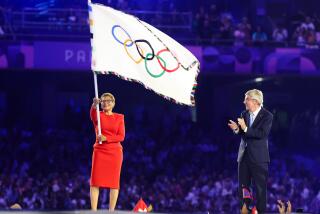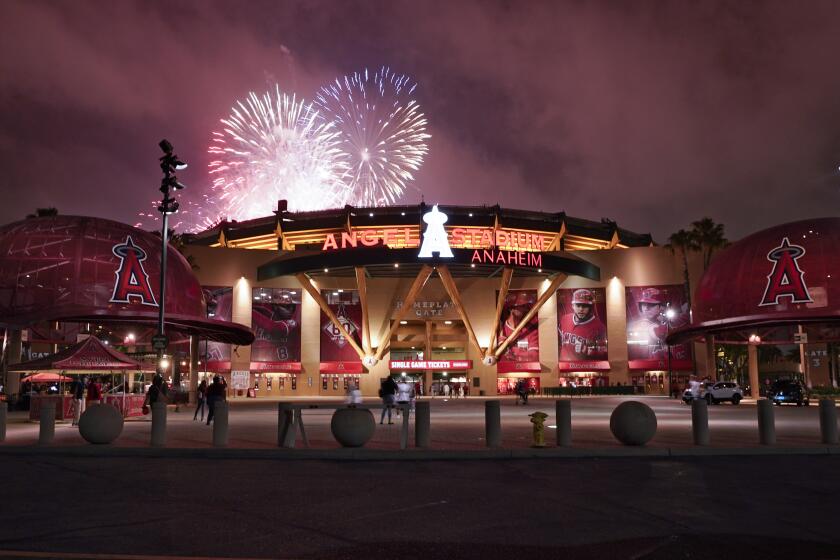L.A. Sports Industry Found Healthy
- Share via
The sports industry in Southern California has proven surprisingly resilient despite the loss of two professional football teams and several annual sporting events as well as a recession that went into double overtime, according to a rare, comprehensive look at the regional sports business released Tuesday.
Not only have annual revenues of sports teams and events held steady at about $800 million--generating about $2 billion each year for the local economy--but attendance and full-time employment increased over a three-year period ending in 1993, the previous time the study, sponsored by the Los Angeles Area Chamber of Commerce and the Los Angeles Sports Council, was done.
The new study, conducted by graduate students under the supervision of the UCLA Anderson School of Management, also found a sharp increase in the number of professional sports teams and an out-of-left-field rise of previously low-profile but affordable sports such as beach volleyball and roller hockey.
“I was surprised, personally,” said chamber President Ezunial Burts. “We’ve seen this sector of the economy hold steady even with the loss of two major professional football teams.”
The phenomenon is reminiscent of Southern California’s much heralded transformation into a “new economy” where hundreds of small entrepreneurs have sprung up in the huge craters left by major corporations that moved out or merged.
In the sports version, the void left by the 1995 departures of the Rams and Raiders may have helped fuel the rise of the Mighty Ducks (hockey), the Galaxy (soccer), the Bullfrogs (roller hockey) and the Piranhas (arena football), among others.
Although the report was greeted with cheers by local boosters, students of the sporting scene were less surprised.
“The economic influence of any individual professional sports team is fairly small in the grand scheme of things,” said Roger Noll, a Stanford University economist who studies professional sports. “More than anything, what this reflects is the improved economy in Southern California,” Noll said. “Sports is a leisure time discretionary activity and it’s very sensitive to business cycles.”
The U.S. sports industry has been growing about 10% to 15% a year, “so if you wait long enough to do the study, it’s bound to improve,” he said.
While he didn’t dispute the findings, Amihai Glazer, chairman of the economics department at UC Irvine, said the economic impact of sports on any area “is trivial.”
A major economic benefit comes from industries that export products or draw people from other areas who spend money here, Glazer said. But when the audience is local, he said, the net effect is a wash: A dollar spent at a sporting event is a dollar not spent at a local movie theater.
Also, although stadiums and teams provide employment, the majority of the jobs are in the minimum-wage range, he said. “It’s not enough to ask how many people are employed at Anaheim Stadium, but what they’d be doing otherwise.”
The study compiled the vital statistics of all Southern California’s professional sports teams--from the Dodgers and Angels of baseball fame to the Wings of cycling obscurity--as well as college athletics, horse racing, major sports venues and annual events such as games at the Rose Bowl, the Los Angeles Open and Virginia Slims tennis tournaments, and the Long Beach Grand Prix. One-time events and postseason games were excluded.
What emerged was a picture of an important local economic engine that, with $801 million in revenue, would have ranked 36th in Los Angeles if the industry were a publicly held company, the study said. That is bigger than such well-known local companies as Coast Savings and Spelling Entertainment Group.
The study estimated that the sports industry’s annual revenue had a ripple effect on the local economy equal to $2.50 for each revenue dollar generated.
And although overall revenue was little changed from the $762 million measured in 1993, “it would be deceptive to say that the industry stood still,” said David Simon, president of the Los Angeles Sports Council, a nonprofit corporation that acts as bidding agent to attract major sporting events to Southern California.
Total attendance at sports events increased 8% to 17 million and full-time employment jumped 53% to 2,628, according to the study, which did not include San Diego.
Jack Kyser, chief economist for the Economic Development Corp. of Los Angeles County, said he is constantly challenged by potential investors about the economic fallout from the defection of the Rams and Raiders.
“Now I can say, ‘Frankly, my dear, we don’t give a damn,’ ” Kyser said.
“Many of these so-called second-tier teams have been doing quite well,” Kyser said. “There are some very exciting niche markets that show what you can do with a good product and an effective marketing campaign.”
Roy Englebrecht, senior vice president of the Piranhas arena football team and the Rancho Cucamonga Quakes minor league baseball team, said the study provides evidence that there is a “growing market for affordable sports” in the region.
But he believes that it also reflects the more sophisticated marketing techniques being employed by owners of minor league and alternative sports franchises. With a growing array of entertainment choices, consumers expect a good show, he said. “If you’re investing this much money [in a team], you’d better be savvy in marketing and entertainment.”
Kyser cited the amount of energy expended in the last several weeks to keep a men’s professional beach volleyball tournament in Manhattan Beach over the objections of a local grass-roots group. The venerable Manhattan Beach Open, which has played to growing crowds over its 38-year history, will instead sink its nets in Hermosa Beach this Friday through Sunday.
The success of the Los Angeles Galaxy soccer team--boosted by savvy marketing, it drew more fans in its 1996 inaugural season than the Raiders did in their final Los Angeles season--should send a message to National Football League owners about the power of marketing to Southern California’s huge Latino population, Kyser said.
The study was not conducted as a tool to influence NFL owners, Simon said, “but we hope it will entice them.”
“The message to a potential NFL team and to the NFL is that not only is sports growing, the economy is growing,” Simon said. “There is no merit to the argument that Los Angeles is not capable of supporting a professional football team.”
Times staff writer Patrice Apodaca in Orange County contributed to this story.
More to Read
Go beyond the scoreboard
Get the latest on L.A.'s teams in the daily Sports Report newsletter.
You may occasionally receive promotional content from the Los Angeles Times.










